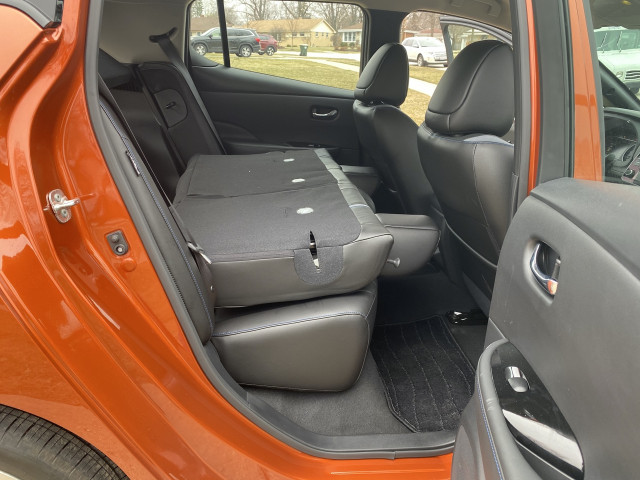Review update: 2021 Nissan Leaf hatchback falls to newer electric crossover SUVs
When the Nissan Leaf electric hatchback went on sale at the end of 2010 it spearheaded the affordable electric vehicle movement. A decade later, it carries up the rear.
The Leaf cost about $7,000 less than the Chevrolet Bolt EV that arrived for 2017. With state incentives, the full federal EV tax credit of $7,500, and discounts from dealers and utilities, the effective price was in the low $20,000s in some cases. The 107 miles of range was a fair tradeoff to the Bolt EV’s 238-mile range at the time. Much has changed since then.
As Tesla launched the less affordable but much more desirable Model 3 compact sedan, Nissan restyled the Leaf in 2018 to look more like its gasoline vehicles. In 2019, Nissan juiced the Leaf with a Plus model and a 226-mile range, but the Leaf still fell short of the Bolt, Model 3, and Hyundai Kona EV.
With a half-dozen affordable electrics available now, including the Ford Mustang Mach-E and Tesla Model Y crossovers, and another dozen coming, including the 2022 Nissan Ariya, the Leaf’s below-average range and its $45,000 price on top Plus models suggest Nissan’s Leaf may have had its last fall.
Its relatively high TCC Rating of 7.2 out of 10 exceeds the rating of the 2021 Bolt EV and 2021 Kona EV, but the steep price of the SL Plus that I tested for a week erases any value advantage.
Miss: Expensive, except in S models
The 2021 Nissan Leaf SL Plus cost $44,845, including destination, and has a EPA-rated range of 215 miles. The base S Plus is $39,000. That’s more expensive than a quicker, sexier, better equipped, and more capable Tesla Model 3 with 263 miles of range, but the Leaf still qualifies for the full $7,500 federal EV tax credit. So the SL Plus could be had for the same as a Model 3, or, if an electric value is the number one concern, a base Leaf S model with just 149 miles that’s reasonably well equipped can be had for $25,000. That’s Nissan’s strongest case with the Leaf, and as soon as the 200,000-unit sales threshold is reached for the EV tax credit, even that most tenuous argument gets halved. Nissan reported in December that it had sold more than 148,000 Leafs.
Hit: Three drive modes

2021 Nissan Leaf

2021 Nissan Leaf Sl Plus

2021 Nissan Leaf Sl Plus
The Leaf isn’t the quickest electric vehicle, but with a 62-kwh battery pack powering a motor that produces 214 hp and 250 lb-ft with front-wheel drive, it springs off the line and jabs up to about 30 mph. Selecting Eco mode adds about 5% to range, or 10 miles with a 200-mile charge, but dampens the pedal feel and removes the quickness that’s characteristic to instant torque. An E-Pedal setting activated with a rocker switch has significant regenerative braking—supplemented with the brake pads—down to a stop.
Hit: Ideal city car
The Leaf’s compact hatch proportions and drive modes suit urban driving. With the E-Pedal active and in Eco mode, I drove 5.3 urban miles and the remaining estimated range increased three miles. Those estimates are based on recent past driving as well as current inputs, so having the HVAC off and the outside temp at 38 degrees helped, but so did regen braking. It averaged 3.6 miles per kwh, which is very efficient. The Leaf can replace the Honda Fit as the perfect city car, as long as you have a home charger.
The Leaf is less amenable on the highway. In the same driving conditions, in Eco mode with the E-Pedal active, and holding steady at 80 mph, the 20-mile trip ate up 40 miles of range. Efficiency dropped to mid-two miles per kwh. Regen braking matters.
In another trip optimizing the three modes for conditions, the trip meter and range meter matched up, and the miles/kwh was in the low threes.
Miss: Cramped cabin
Most electric vehicles benefit from an open floor plan because with a motor at either or both axles, there’s no driveshaft tunneling through the center. It makes the cabins feel more spacious, and lets designers optimize packaging for a relatively small footprint. Not the Leaf. The wide console extends from the center stack with a broad panel occupied by a shifter bulb. The Eco button and E-Pedal rocker switch are housed in the same spot, so there’s no confusion, but it takes up a big and seemingly unnecessary chunk of space, where even gas cars now have tiered storage compartments where electric gear shifters have replaced mechanical ones. The packaging compromises front leg room, especially for the front passenger.
Miss: Limited cargo space

2021 Nissan Leaf Sl Plus

2021 Nissan Leaf Sl Plus

2021 Nissan Leaf Sl Plus
The Leaf has 23.6 cubic feet of space behind the rear seats, which let us cram in my daughter’s hockey bag due to the deep well. But fold the seats down and the deep hatch rises up at least 8 inches to the folded seat backs for a staggered cargo area. It fits 30 cubic feet behind the front seats, whereas the Bolt EV and Tesla Model Y exceed 56 cubic feet. The difference is based on how Nissan arranged its battery packs under each set of seats and the rear seat floor, whereas other automakers stretch the packs out between the axles for a flat floor.
Nissan may not turn over a new Leaf, but the five-door electric that charged a movement still makes for a good city car and can be had for a good deal in base models.
_______________________________________
2021 Nissan Leaf SL Plus
Base price: $44,825, including $925 destination
Price as tested: $45,630
Drivetrain: 62-kwh battery with 160-kw motor making 214 hp with front-wheel drive
EPA range and fuel economy: 215 miles and 104 MPGe
The hits: Drive modes, urban range
The misses: Expensive, cramped cabin

